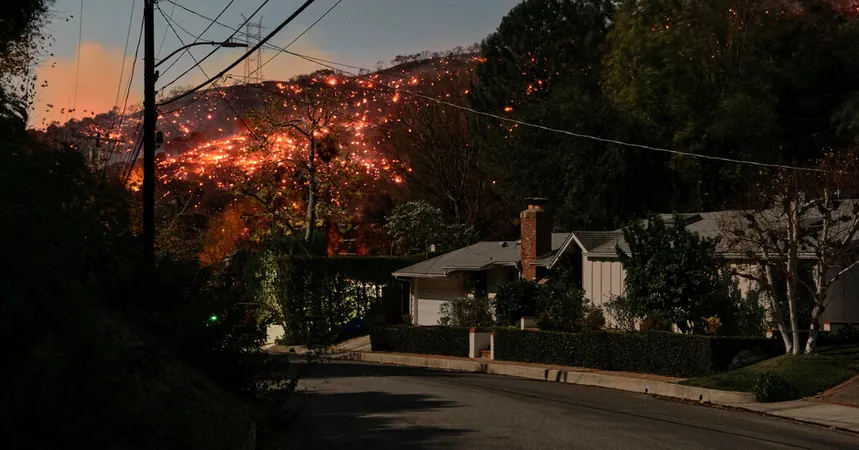
California's Insurance System on Edge as Wildfire Losses Soar: Will It Survive?
2025-01-14
Author: Jessica Wong
Introduction
California's insurance market is facing a pivotal moment as the state grapples with unprecedented wildfire losses. The outcome may hinge on a crucial question: Can the California FAIR Plan, a program designed to cover high-risk homes, sustain its financial stability amid escalating claims?
Background of the California FAIR Plan
Originally established in 1968, the California FAIR Plan was designed to offer coverage for individuals unable to secure standard homeowners insurance due to various risk factors. However, as climate change intensifies, leading to an alarming rise in both the frequency and intensity of wildfires, commercial insurers have begun to withdraw from the market. Consequently, the FAIR Plan has become an essential lifeline for thousands of homeowners, but it is now under severe strain.
Current Financial Concerns
Recent wildfires in Los Angeles have raised alarms regarding the FAIR Plan's ability to manage the resulting claims. As of last week, reported available funds were just $377 million, a number that pales in comparison to the projected $30 billion in insured losses from the devastating fires. With flames still raging, predictions suggest that the financial toll may escalate significantly.
The Distinct Role of the FAIR Plan
What sets the FAIR Plan apart from traditional insurers is its mandate to cover homes in high-risk areas, unlike regular companies that can refuse such coverage. This caveat has resulted in a rapid increase in properties insured by the FAIR Plan—during the period from 2020 to 2024, the number of homes under its umbrella more than doubled, now encompassing nearly half a million properties worth approximately $500 billion.
Impact of Recent Wildfires
Recent statistics from the Federal Emergency Management Agency (FEMA) reveal that over 1,000 homes have been lost to the blazes in Pacific Palisades alone, with damage reported to thousands more and tens of thousands more at risk.
Operational Finances and Challenges
Under typical circumstances, the FAIR Plan does not disclose operational finances publicly; a spokesperson confirmed only that the organization is prepared for disaster. However, with its financial resources already overwhelmed, officials are scrutinizing how the plan will respond to overwhelming claims.
Reinsurance as a Safety Net
Senator Alex Padilla’s office indicated that the FAIR Plan indeed has approximately $5.75 billion in reinsurance coverage, which could play a pivotal role in addressing its financial obligations. Reinsurance essentially acts as a safety net for insurers, but if the claims exceed both the plan’s funds and its reinsurance, the plan might need to request additional revenue from California's insurance companies to cover the shortfall. This potential 'assessment' could lead to further complications as insurers already struggling to operate within the state might reconsider their presence in the market.
Bipartisan Concerns
As concerns mount, there are voices in Congress worried about the implications of the FAIR Plan's financial instability. Senator Sheldon Whitehouse highlighted the broader risks associated with state-backed insurance systems, noting that 'climate-caused uninsurability could trigger cascading failures that undermine our entire economy.'
Warnings from the FAIR Plan's Leadership
Furthermore, the president of the FAIR Plan, Victoria Roach, warned lawmakers last year of the weight of risk the plan bears. She asserted, 'We are one event away from a large assessment,' which reflects the urgent need for financial stability. As the FAIR Plan navigates these treacherous waters, it faces looming challenges, including regulatory hurdles that cap its ability to raise premiums necessary to remain solvent.
Conclusion
In this climate of uncertainty, homeowners, insurers, and policymakers alike are holding their breath. As California's wildfire season continues to escalate, one can only wonder: is this the tipping point for the state’s insurance infrastructure? The implications stretch beyond individual homeowners—potentially reshaping California’s economic landscape as we know it.
 Brasil (PT)
Brasil (PT)
 Canada (EN)
Canada (EN)
 Chile (ES)
Chile (ES)
 Česko (CS)
Česko (CS)
 대한민국 (KO)
대한민국 (KO)
 España (ES)
España (ES)
 France (FR)
France (FR)
 Hong Kong (EN)
Hong Kong (EN)
 Italia (IT)
Italia (IT)
 日本 (JA)
日本 (JA)
 Magyarország (HU)
Magyarország (HU)
 Norge (NO)
Norge (NO)
 Polska (PL)
Polska (PL)
 Schweiz (DE)
Schweiz (DE)
 Singapore (EN)
Singapore (EN)
 Sverige (SV)
Sverige (SV)
 Suomi (FI)
Suomi (FI)
 Türkiye (TR)
Türkiye (TR)
 الإمارات العربية المتحدة (AR)
الإمارات العربية المتحدة (AR)